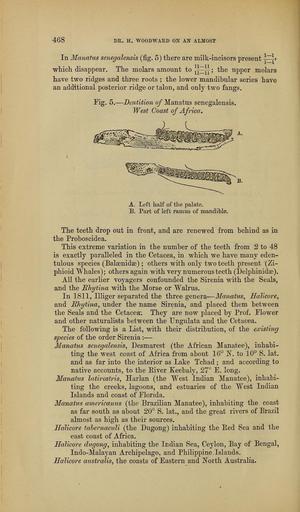MAKE A MEME
View Large Image

| View Original: | The_Quarterly_journal_of_the_Geological_Society_of_London_(14073271031).jpg (1183x2018) | |||
| Download: | Original | Medium | Small | Thumb |
| Courtesy of: | commons.wikimedia.org | More Like This | ||
| Keywords: The Quarterly journal of the Geological Society of London (14073271031).jpg 468 <br> DE H WOODWAED Olf Al ALMOST <br> In Manatus senegalensis fig 5 there are milk-incisors present - <br> wliich disappear The molars amount to J ; the upper molars <br> have two ridges and three roots ; the lower mandibular series have <br> an additional posterior ridge or talon and only two fangs <br> Pig 5 ” Dentition of Manatus senegalensis <br> West Coast of Afnca <br> A Left half of the palate <br> B Part of left ramus of mandible <br> The teeth drop out in front and are renewed from behind as in <br> the Proboscidea <br> This extreme variation in the number of the teeth from 2 to 48 <br> is exactly paralleled in the Cetacea in which we have many eden- <br> tulous species Balaenidse ; others with only two teeth present Zi- <br> phioid Whales ; others again with very numerous teeth Delphinidse <br> All the earlier voyagers confounded the Sirenia with the Seals <br> and the Rhytina with the Morse or Walrus <br> In 1811 Illiger separated the three genera ” Manatus Halicore <br> and EJiytina under the name Sirenia and placed them between <br> the Seals and the Cetacea They are now placed by Prof Plower <br> and other naturalists between the Ungulata and the Cetacea <br> The following is a List with their distribution of the existing <br> species of the order Sirenia ” <br> Manatus senegalensis Desmarest the African Manatee inhabi- <br> ting the west coast of Africa from about 16° JST to 10° S lat <br> and as far into the interior as Lake Tchad ; and according to <br> native accounts to the Eiver Keebaly 27° E long <br> Manatus latirostris Harlan the West Indian Manatee inhabi- <br> ting the creeks lagoons and estuaries of the West Indian <br> Islands and coast of Plorida <br> Manatus americanus the Brazilian Manatee inhabiting the coast <br> as far south as about 20° S lat and the great rivers of Brazil <br> almost as high as their sources <br> HaJicore tahernaculi the Dugong inhabiting the Eed Sea and the <br> east coast of Africa <br> Halicore dugong inhabiting the Indian Sea Ceylon Bay of Bengal <br> Indo-Malayan Archipelago and Philippine Islands <br> Halicore australis the coasts of Eastern and jN orth Australia 37047338 114009 51125 Page 468 Text 41 http //www biodiversitylibrary org/page/37047338 1885 Geological Society of London NameFound Cetacea NameConfirmed Cetacea EOLID 7649 NameBankID 2478494 NameFound Ejiytina NameFound Halicore NameConfirmed Halicore NameBankID 4185072 NameFound Halicore australis NameConfirmed Halicore australis NameFound Halicore dugong NameConfirmed Halicore dugong NameFound Manatus NameConfirmed Manatus EOLID 4442019 NameBankID 113011 NameFound Manatus americanus NameConfirmed Manatus americanus NameFound Manatus latirostris NameConfirmed Manatus latirostris NameFound Manatus senegalensis NameConfirmed Manatus senegalensis NameFound Proboscidea NameConfirmed Proboscidea EOLID 1643 NameBankID 4934169 NameFound Rhytina NameConfirmed Rhytina NameBankID 4332298 NameFound Sirenia NameConfirmed Sirenia EOLID 8708 NameBankID 2482684 NameFound Ungulata NameConfirmed Ungulata EOLID 4530122 NameBankID 6655833 Biodiversity Heritage Library The Quarterly journal of the Geological Society of London v 41 1885 Geology Periodicals Smithsonian Libraries bhl page 37047338 dc identifier http //biodiversitylibrary org/page/37047338 smithsonian libraries Information field Flickr posted date ISOdate 2014-04-30 Check categories 2015 August 26 CC-BY-2 0 BioDivLibrary https //flickr com/photos/61021753 N02/14073271031 2015-08-26 04 51 33 cc-by-2 0 PD-old-70-1923 The Quarterly journal of the Geological Society of London 1885 Photos uploaded from Flickr by Fæ using a script | ||||